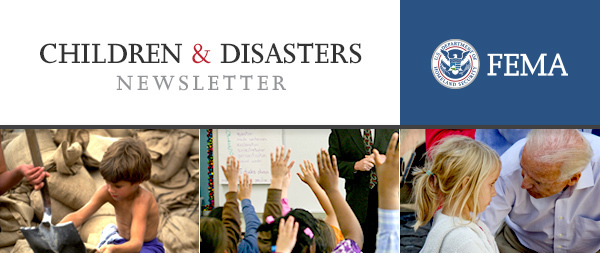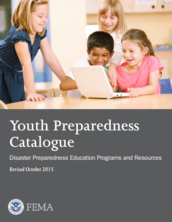NOVEMBER 2015 - ISSUE 11

 November is Native American Heritage Month, which
provides a platform for tribal communities to share their culture
and traditions. On Native American reservations in the United States, as elsewhere, it’s
important to prepare for emergencies, including natural disasters.
FEMA Youth Preparedness Council (YPC) member Hailey
Starr is committed to strengthening her community on the Muckleshoot
Reservation in the Pacific Northwest. In a recent FEMA blog post, Amanda Osborn interviewed
Hailey, who said her interest in emergency management and preparedness began
when she joined the Muckleshoot Teen Community Emergency Response Team. “I
realized that the reservation isn’t prepared,” Hailey said. “I wanted to do
something to change that.” Read the full story.
Hailey recently presented her work at the National Congress of American Indians' annual conference on a panel discussing emergency management. Alongside her on the panel were native youth from Sherman Indian High School, an off-reservation boarding high school for Native Americans located in Riverside, California. The high school students spoke about a poster they created to alert native peoples living in California to fault lines in the state. The poster includes a map of the fault lines, and translations of the earthquake drill “Drop! Cover! Hold On!” in all the native languages represented at the high school and in California.
|
In 2007, following catastrophic wildfires in Southern
California, tribal leadership of the Kumeyaay, Luiseño, Pupeño, and Kiowa
tribal groups formed the Inter Tribal
Long Term Recovery Foundation to prepare residents on 17
tribal reservations for local hazards. Since youth and elders usually spend the
most time on the reservation, while working adults are more often away, tribal
leaders and emergency managers knew it was important to develop a Teen
Community Emergency Response Team (CERT) program.
Fourteen teens representing the Los Coyotes Band of
Cahuilla Indians completed the foundation’s first Teen CERT training in 2012. Since
then, the Santa Ysabel Band of Kamea Indians and some youth in the foundation’s
AmeriCorps program have participated in Teen CERT training, as well.
“[The program] has been successful because we focus on our
tribal communities, what makes them unique, and what makes them different from
neighboring jurisdictions, cities, or urban areas,” said the foundation’s executive
director Theresa Gregor. “I think it gives people a better sense of place and
how to respond to what is going to happen on their land and in their homes.”
Learn more about the foundation and its Teen CERT program at www.itltrf.org.
It is not too late to register for the 63rd IAEM Annual Conference, November 13–18, 2015, in Clark County, Nevada. Discover for yourself why the IAEM Annual Conference is consistently described as the premiere event for emergency managers. More than just another conference, IAEM gives you innovative ideas, opportunities to network with experts and peers, and important information on professional practices and issues. Plus, you will leave with strategies and tools that you can implement in your organization. Learn more.
Can’t attend? Join the IAEM Conference via the IAEM Digital Pass, which will give you access to several live streamed and recorded keynote and plenary sessions, one recorded session in each spotlight and breakout session block, and the EMvision Talks session. Attendees who register for the full conference will receive a complimentary digital pass and can view sessions they missed in person. For complete details, view the Digital Pass page.
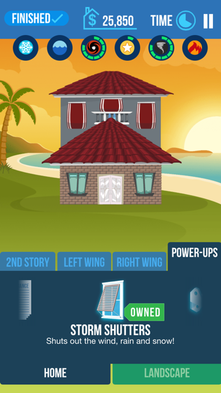 The nonprofit Federal Alliance for Safe Homes (FLASH®) partnership released its latest creative take on disaster safety awareness with the introduction of a children’s social gaming app called Last House Standing. The free smartphone and tablet app is offered by the same team that created several well-known public awareness campaigns, including StormStruck: A Tale of Two Homes®; Turn Around, Don't Drown®; and Go Tapeless®. The app provides a fun way to introduce the next generation to one central point: that how and where you build is the most fundamental element of disaster survival for families and homes.
"Our goal is to introduce players to the idea that their choices help determine their level of disaster resilience," said FLASH President and CEO Leslie Chapman-Henderson. "The app does this by [presenting] serious options about whether to build using hurricane shutters or other strengthening features like metal connectors, [along with] dozens of fantasy options, from castle moats to space domes. With only three minutes and a $100,000, players have to think fast to survive the disasters, but they learn that it can be done."
Last House Standing is available for download in the iTunes Store and at Google Play.
|
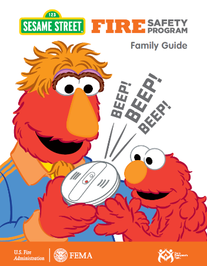 A newly released version of the Sesame Street® Fire Safety Program for preschool kids
is now available! The U.S. Fire Administration, in collaboration
with the Sesame Workshop, updated the program, which is designed to help
educators and families teach children ages three to five essential fire safety
information and skills.
Using
familiar characters from Sesame Street, the Fire Safety Program illustrates
ways to prevent fires and what to do if there is a fire. The program includes a
teacher’s
guide, a family guide, a CD with songs and stories,
a coloring and activity booklet, and a poster. These materials are
available for free in both English and Spanish at Sesame Street Fire
Safety Program.
|
 The Texas A&M Engineering Extension
Service’s (TEEX) National Emergency Response and Rescue Training Center offers a Pediatric Disaster Response and Emergency Preparedness
training course. Funded by DHS/FEMA and TEEX, this 16-hour course is provided
throughout the United States and its territories at no cost to participants. By
incorporating case studies and small group exercises, students can discuss
concepts and share ideas about pediatric disaster preparedness with each other.
Students also review their community’s preparedness and identify weaknesses or
gaps. They complete the course with a list of ways to bridge gaps and items to discuss
and address within their communities. The course has been delivered in 27
states to more than 1,400 participants in the first year of its availability.
Contact Juan Guerrero at juan.guerrero@teex.tamu.edu with
any questions or to schedule the course in your community. See also the course listing on the TEEX website.
|
This September and October, Save the Children’s Get Ready Get Safe initiative partnered with Primrose Schools® to help families
prepare for emergencies. The nine-week series guided families through a preparedness
checklist with blog posts, short videos, and resources to make emergency planning easy. Use this great series to prepare your own family and share with your schools and communities! Families start by taking a pledge and then create
a home plan, build disaster supply kits, and note their emergency contacts. |
|
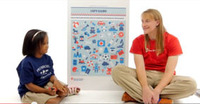 |
|
Each year, the American Academy of Pediatrics (AAP) aims to
support health care providers and others who care for children to employ
influenza prevention and control strategies in order to increase influenza
immunization rates, promote early and aggressive treatment, and support an
improved infrastructure for influenza outbreaks or pandemics. AAP developed a
new influenza prevention and control infographic to
emphasize the importance of influenza vaccination and treatment in children,
especially those at highest risk. Other new influenza resources include:
For more information on AAP influenza
prevention and control or other disaster preparedness and response activities, visit
www.aap.org/disasters or
e-mail DisasterReady@aap.org.
|
|
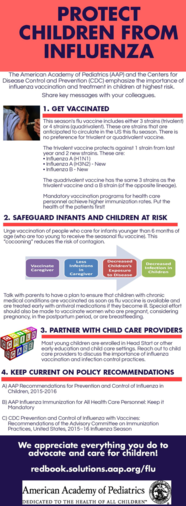 |
Email: FEMA-Youth-Preparedness@fema.dhs.gov
Online: www.ready.gov/youth-preparedness
|









